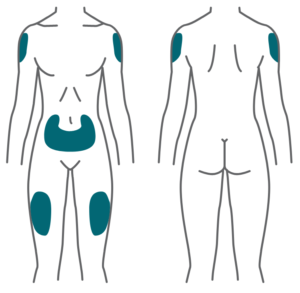How much weight can you lose on Ozempic?
Ozempic or semaglutide (generic name) is a once weekly injection for the treatment of type 2 diabetes. It is used along with diet, exercise and other medications to control blood sugar levels in patients with type 2 diabetes.
How does it work? Ozempic for weight loss and blood sugar control
Ozempic belongs to a class of medications called glucagon-like peptide-1 (GLP-1) agonists. It works by signalling the body to produce more insulin when the blood sugar level is high. It is thought to help with weight loss by slowing down the emptying of the stomach, thus making you feel full quicker. Furthermore, it also acts in areas of the brain that regulate appetite and food intake. Together, these functions can help you feel less hungry, causing you to eat less food and lose more weight. If you don’t like taking an injection, Rybelsus (oral semaglutide) may be an option for you.
Evidence for Weight loss for Ozempic during clinical trial
Ozempic had multiple clinical trials across multiple countries involving thousands of patients. I will summarize the weight loss in each trial below along with a link to the published article if you are interested in reading up on more details. Note: I’m just listing the mean absolute weight loss that was reported in the patients that were taking Ozempic, check out the trial to see how it compares to the placebo or comparison group.
In Sustain 1 trial at week 30, patients that were taking 0.5 mg of ozempic weekly had an average weight loss of 8.22 lbs (3.73 kg) and patients that were taking 1 mg of ozempic weekly had an average weight loss of 9.98 lbs (4.53 kg).
In Sustain 2 trial at week 56, patients that were taking 0.5 mg of ozempic weekly had an average weight loss of 9.48 lbs (4.3 kg) and patients that were taking 1 mg of ozempic weekly had an average weight loss of 13.44 lbs (6.1 kg).
In Sustain 3 trial at week 56, patients that were taking 1 mg of ozempic weekly had an average weight loss of 12.34 lbs (5.6 kg).
In Sustain 4 trial at week 30, patients that were taking 0.5 mg of ozempic weekly had an average weight loss of 7.65 lbs (3.47 kg) and patients that were taking 1 mg of ozempic weekly had an average weight loss of 11.40 lbs (5.17 kg).
In Sustain 5 trial at week 30, patients that were taking 0.5 mg of ozempic weekly had an average weight loss of 8.16 lbs (3.7 kg) and patients that were taking 1 mg of ozempic weekly had an average weight loss of 14.11 lbs (6.4 kg).
In Sustain 6 trial at week 104, patients that were taking 0.5 mg of ozempic weekly had an average weight loss of 7.94 lbs (3.6 kg) and patients that were taking 1 mg of ozempic weekly had an average weight loss of 10.80 lbs (4.9 kg).
In Sustain 7 trial at week 40, patients that were taking 0.5 mg of ozempic weekly had an average weight loss of 10.14 lbs (4.6 kg) and patients that were taking 1 mg of ozempic weekly had an average weight loss of 14.33 lbs (6.5 kg)
In conclusion, the studies showed that you can lose a significant amount of weight on Ozempic while improving your blood sugar control. Higher dose of Ozempic was associated with greater weight loss. On average, in the first 6 months to a year, the clinical trials have shown that you can lose 7-10 lbs on ozempic 0.5 mg weekly dose and 10-14 lbs on ozempic 1 mg weekly dose.
Ozempic lowers the risk of heart attack and stroke
Patients with type 2 diabetes are at higher risk of heart attack, stroke and kidney disease. Taking ozempic has been shown to lower the risk of heart attack, stroke and death in adults with diabetes and known heart disease. It may also reduce the risk of new kidney disease or slow down the worsening of kidney disease.
Ozempic dose
Initially, you will be started on ozempic 0.25 mg subcutaneous injection once a week for 4 weeks and then increased to 0.5 mg one weekly. After a further 4 weeks on 0.5 mg weekly dose, it can be increased to 1 mg once weekly to get better blood sugar control if needed. You are started on a lower dose and increased slowly to help reduce side effects and make ozempic more tolerable. You should take ozempic as prescribed by your doctor.
How to inject Ozempic
Ozempic Instructions

Prepare your pen
Check your Ozempic pen
Read the label to check that your pen contains Ozempic®. Make sure that the Ozempic® medicine in your pen is clear and colorless.
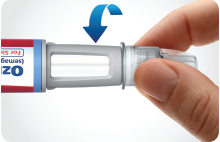
Attach a new needle
Tear off the paper tab. Push and turn the needle on until it is tight. Pull off both needle caps.
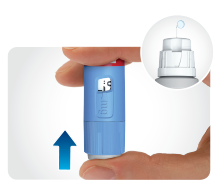
Check the Ozempic® flow with each new pen
Turn the dose selector until the dose counter shows the flow check symbol. Press and hold in the dose button until the dose counter shows 0. Make sure a drop appears at the needle tip.
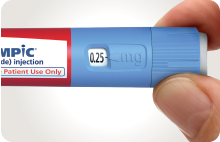
Give your injection
Select your dose
Turn the dose selector until the dose counter shows the dose you need to inject (0.25 mg or 0.5 mg for the red‑label pen, 1 mg for the blue‑label pen).
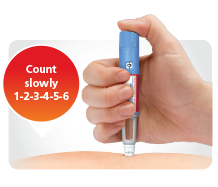
Inject your dose
Insert the needle into your skin. Press and hold down the dose button. After the dose counter reaches 0, slowly count to 6. Remove the needle from your skin.

After your injection
Carefully remove the needle and place it in a sharps container. Put the pen cap back on the pen.
What do I do if I miss a dose of Ozempic
If you have missed your usual dose of ozempic and it has not been more than 5 days, you should take the ozempic dose as soon as possible and resume your usual schedule thereafter. If it has been more than 5 days since the missed dose, you should skip the missed dose and continue your usual weekly schedule.
How should I store Ozempic
Unopened injection pens should be stored in the fridge (not freezer) at 36ºF to 46ºF (2–8°C) until the expiration date. Do not place them directly next to the cooling element and do not freeze them; if freezing has occurred, the pen should not be used. After using a pen, they may be stored at room temperature (59°F to
86°F; 15°C to 30°C) or in a fridge for up to 56 days.
What are the side effects of Ozempic
The most common side effects you are likely to experience with Ozempic is nausea, vomiting, diarrhea and abdominal pain. To reduce the risk of side effects, it is started at a lower dose and increased slowly. These side effects tend to occur during dose increase and tend to decrease over time; but if it is intolerable, you may have to stop taking ozempic and speak to your doctor.
Rarely, it may cause pancreatitis – inflammation of your pancreas. Patient that have a previous history of pancreatitis are at higher risk of it. If you get vomiting or severe pain in abdomen or back, seek medical attention immediately. Rarely you may experience an allergic reaction. Seek medical attention right away if you have any signs of an allergic reaction such as rash, hives, swelling of the lips/tongue/throat or difficulty breathing.
If you or someone in your family has medullary thyroid carcinoma (MTC) or Multiple Endocrine Neoplasia syndrome type 2 (MEN 2), you should not take ozempic. In animal studies, ozempic caused thyroid C-cell tumours but it is unknown whether it causes the same in humans. if you are on Ozempic, you should monitor for symptoms of thyroid tumours such as a mass in the neck, trouble swallowing, shortness of breath and persistent hoarseness.
Is Ozempic safe in pregnancy and breast feeding
Ozempic should be stopped more than 2 months prior to becoming pregnant. If you are on ozempic and childbearing age, consider using birth control. It is not known if ozempic is present in breast milk. You should talk to your doctor to consider the risks vs benefits.
What are the alternatives to Ozempic?
Ozempic is in high demand right now and may not be readily available. Other drugs that work similar to ozempic and can be used as an alternative include:
- Wegovy (semaglutide): a once weekly injection
- Rybelsus (semaglutide): a oral tablet taken once daily
- Mounjaro (Tirzepatide): once weekly injection
- Trulicity (Dulaglutide): once weekly injection
- Victoza (Liraglutide): once daily injection
Questions from readers:
Is Ozempic insulin?
Ozempic is not insulin. Ozempic works by increasing the natural insulin product by the pancreas in your body, but Ozempic is not an insulin injectin
How much weight can you lose in a month with ozempic?
It is hard to predict how much weight you can lose in a month while on ozempic. Most of the trials used a longer time-frame of several months and higher doses were associated with more weight loss. Since you start at a lower dose and then titrate up, you might not see significant weight loss in the first month but if you stick with it, studies shows that you are likely to achieve weight loss.
If you have any questions, please feel free to contact us . Note: We can only answer generic questions about the medication. We cannot provide you medical advice, please speak to your doctor or pharmacist.
Disclaimer: We have made every effort to ensure that all information is factually correct and up to date, however this article is not comprehensive and does not contain all relevant information about the topic. IT should not be used as a substitute for the knowledge and expertise of a licensed healthcare professional. You should consult your doctor or pharmacist before taking any medication. The drug information contained herein is subject to change and is not intended to cover all possible uses, directions, precautions, warnings, drug interactions, allergic reactions, or adverse effects. The absence of warnings or other information for a given drug does not indicate that the drug or drug combination is safe, effective, or appropriate for all patients or all specific uses.
